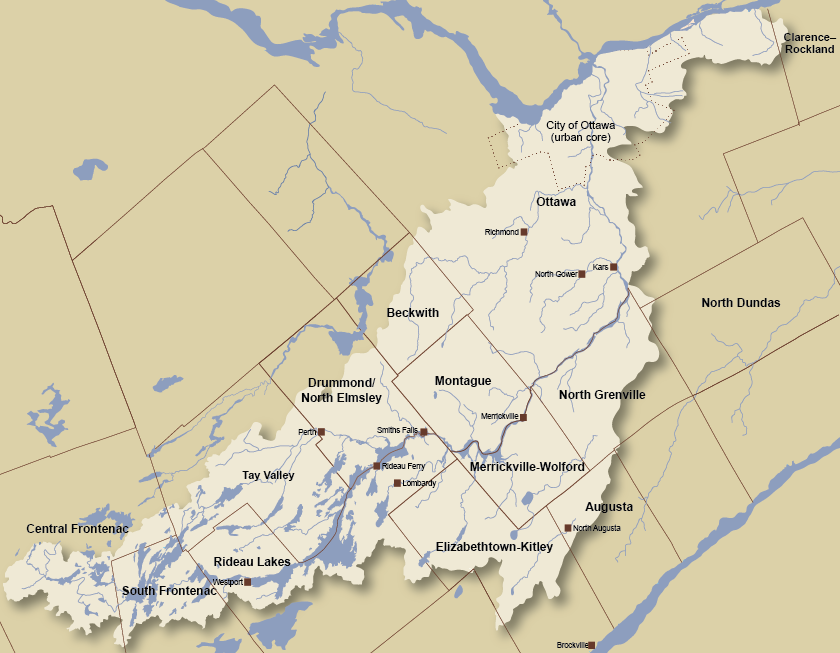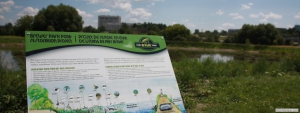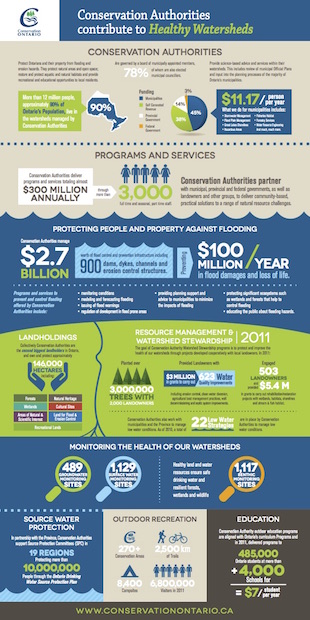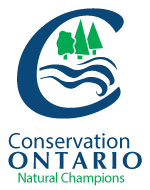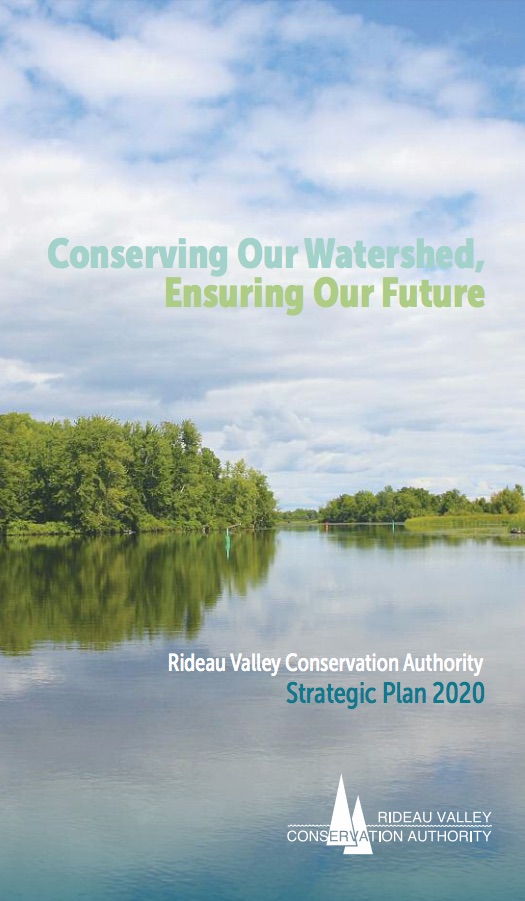Super User
Watershed Conditions Statement: Water Safety
A mix of precipitation forecast for tonight through to Thursday can be expected to cause some increase in levels in in all watercourses throughout the Rideau River Valley.
It is unclear what will be the predominant form of precipitation that will fall over the next two days. If it is mainly rain, much of that will be retained in the snowpack but some runoff can be expected to occur and water levels will increase on all watercourses.
Brewer Park Project Wins Prestigious National Conservation Award
Brewer Park Pond Restoration Project has received the Top Canadian Fishing Industry Conservation Project Award for 2015. This award, presented at the Spring Fishing and Boat Show at the International Centre in Mississauga, ON is determined by a vote of the members of the Canadian Angling Hall of Fame.
For Muskies Canada (Ottawa Chapter) and the Rideau Valley Conservation Authority (RVCA), this is the second year in a row where one of their partnership projects has received recognition. In 2014, the partners were recognized for work to create nursery and feeding habitat for fish along the Jock River in Richmond.
January Thaw
After waiting for so long for snow to arrive, above freezing temperatures and rain forecast for tomorrow and Sunday can be expected to reduce the snow cover and cause increased water levels and flows in the Rideau watershed.
Water levels on lakes and flows in watercourses are close to normal for the time of year. However, as conditions change through this thaw period, levels will increase and ice on lakes, ditches, local streams and rivers that had just begun to form will become more unstable posing potential safety risks. Caution should be exercised by everyone when near local streams and rivers. Parents should inform their children of the risks associated with increased flows and unstable ice conditions in area watercourses and provide appropriate supervision. An extended period of cold temperatures is needed for a stable ice cover to form.
Conservation Authorities Contribute to Healthy Watersheds
RVCA is a member of Conservation Ontario
Butternut Recovery
We are working to help butternut persist on the landscape.
The Butternut Canker Disease is threatening the very survival of Butternut across the entire natural range in North America including the Butternut populations in eastern Ontario.
Butternut Recovery Program:
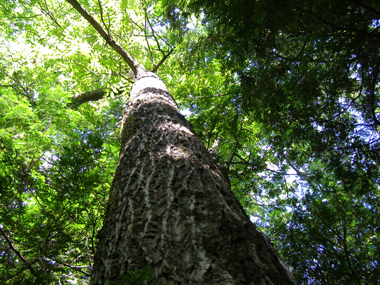
- informs landowners about the endangered status of Butternut and encourages them to maintain their healthy trees
- locates, assesses and maps healthy Butternut trees, to be logged in a seed-source geodatabase
- collects seeds from healthy trees and those showing signs of tolerance throughout Eastern Ontario
- grows seedlings from these seeds each fall at the Ferguson Forest Centre in Kemptville for the Landowner Butternut Planting Program, which:
- distributes 2,000 vigorous seedlings to hundreds of landowners across Eastern Ontario to replace dead and dying Butternut trees
- tracks survival and health of planted Butternuts via landowner volunteer reporting
- continually re-assesses the health of the butternut seed trees in the database and forecasts seed crops each summer
- collects leaves or buds from seed trees to DNA test for hybridization to ensure we are only collecting seeds from pure Butternut
- makes tolerant trees available for cloning to support the long-term grafting program managed by the Forest Gene Conservation Association (FGCA)
Species At Risk Compensation Program:
- makes Butternut seedlings available within MNRF Seed Zones 35 and 36 for MECP (Ministry of Environment, Conservation & Parks) compensation permits
- Seedlings are planted and maintained at several butternut groves on RVCA properties across the watershed
- These groves will be managed long-term as Butternut Seed Orchards for the recovery program.
Why Are Butternut Endangered?
Butternut trees in Eastern Ontario and across their entire natural range in North America are under attack by the Butternut Canker Disease. This is a deadly fungal disease that attacks all Butternut trees regardless of their age or size. There is no known cure for the disease but there is hope in locating trees that appear to have a natural tolerance to the disease. These rare individuals are the focus of the recovery program in Ontario for seed collection to produce vigorous seedlings for out-planting and to clone the genetic material of these trees through grafting in an effort to eventually save the species.
Butternut is classified as an endangered species under the Ontario Endangered Species Act (ESA 2007). It is illegal to harm or kill a naturally occurring Butternut tree without a Butternut Health Assessment. Seedlings planted through our program are exempt from the protection of the ESA.
Why are Butternut Important?
The Butternut (Juglans cinerea) is a native tree species that has co-existed as part of the Eastern Ontario forests for thousands of years. In Canada, it grows across southern Ontario, Quebec and New Brunswick. The presence of Butternut is important for several historical, ecological, economic and medicinal reasons: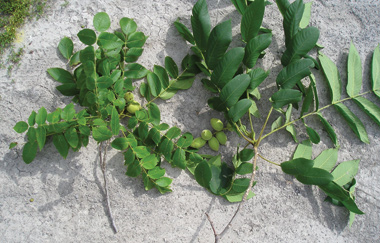
- Butternut wood is cherished for fine furnishings, paneling, carving and turning
- Butternut bark, roots, nut oil and husks all have medicinal qualities ranging from arthritis and headache relief to lowering human cholesterol (please seek medical advice before trying)
- Butternut is an important food source for small mammals, birds and humans
- Edible nuts were used by First Nations and settlers for their high oil content and concentration of omega-3 fatty acids; the dried nuts can be stored for years
Get Involved!
There are three ways to get involved:
- If you have healthy butternut. Please contact Rose at
- If you want to plant butternut. Please contact Ian at
- If you want to volunteer to help collect seeds, let us know. Please contact Ian at
Contact:
Rose Fleguel, Butternut Recovery Technician
613-858-3678
Resources:
Strategic Plan
Annual Reports
RVCA is pleased to provide highlights of its many accomplishments through its annual report. You can view them below:
Annual Reports
The Rideau Watershed
Our Watershed
The Rideau River drains an area of over 4,000 square kilometres of Eastern Ontario. The main stem of the river flows in a northerly direction from Upper Rideau Lake near Newboro to the City of Ottawa where it tumbles over Rideau Falls into the Ottawa River. Total length of the longest part of the watershed is about 180 kilometres. From the highest point in the valley (Carnahan Lake in the Tay sub-watershed) to the Ottawa River is a drop of 204 metres in elevation. About 620,000 people live in the watershed including a large part of the City of Ottawa, the fourth largest metropolitan area in Canada. There are 18 municipalities within the valley and most people, outside of Ottawa, draw their drinking water from the river or from groundwater.
